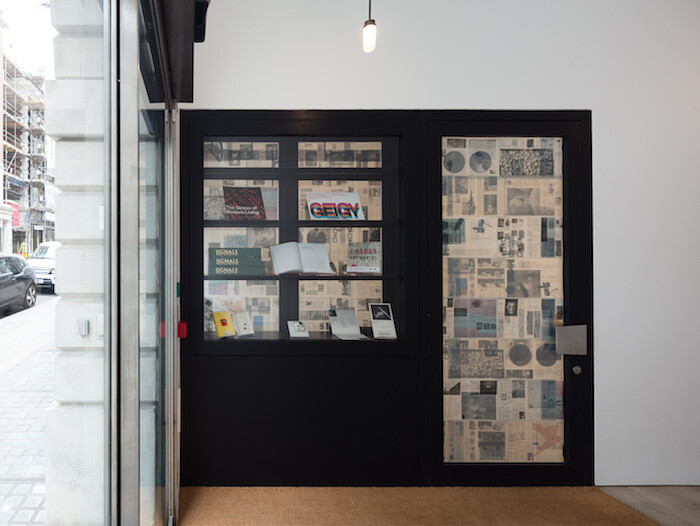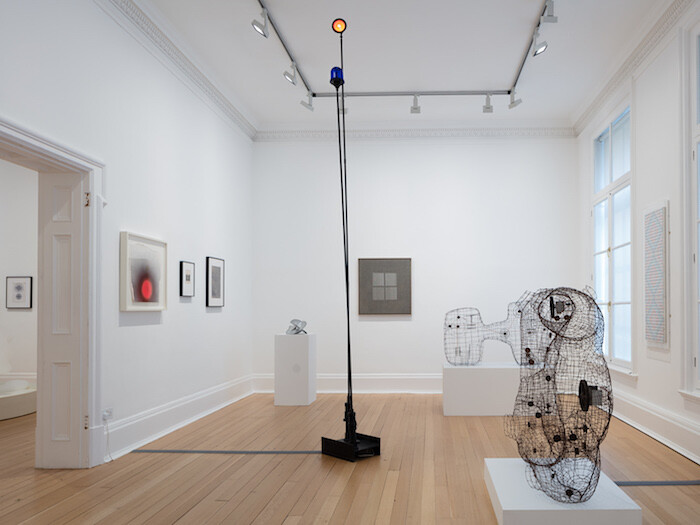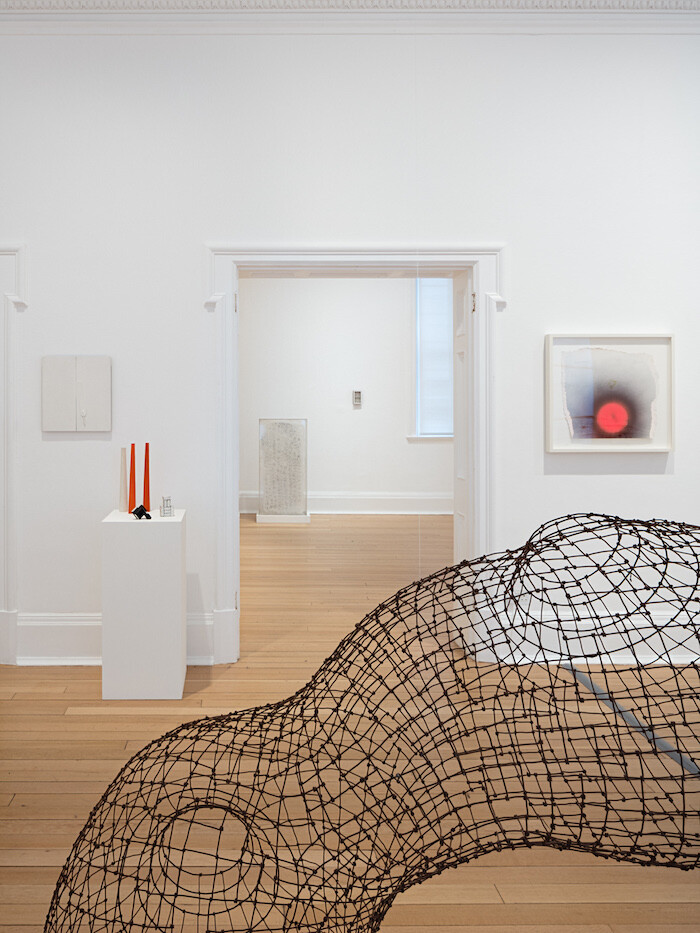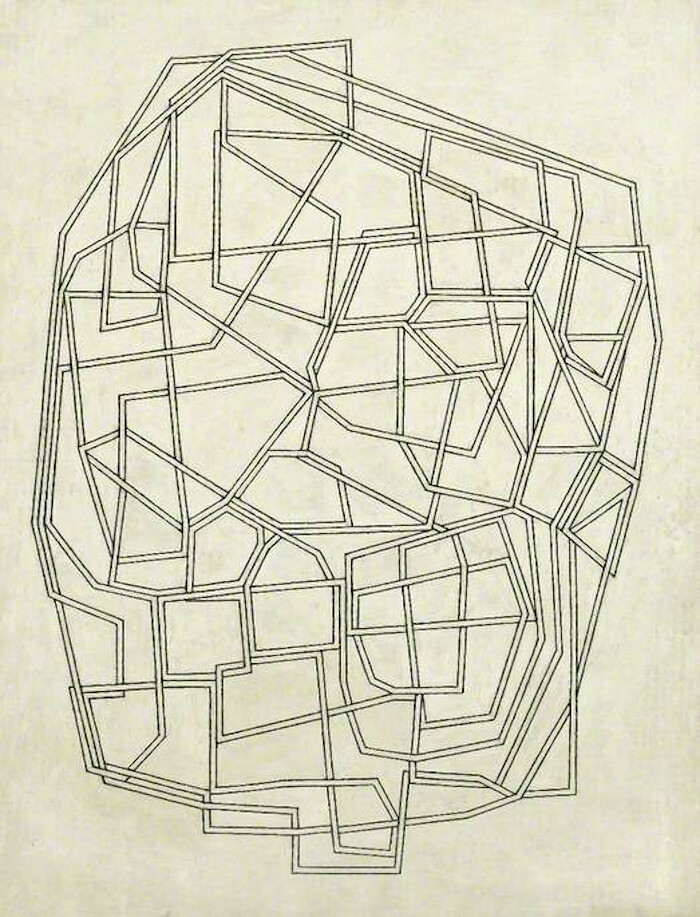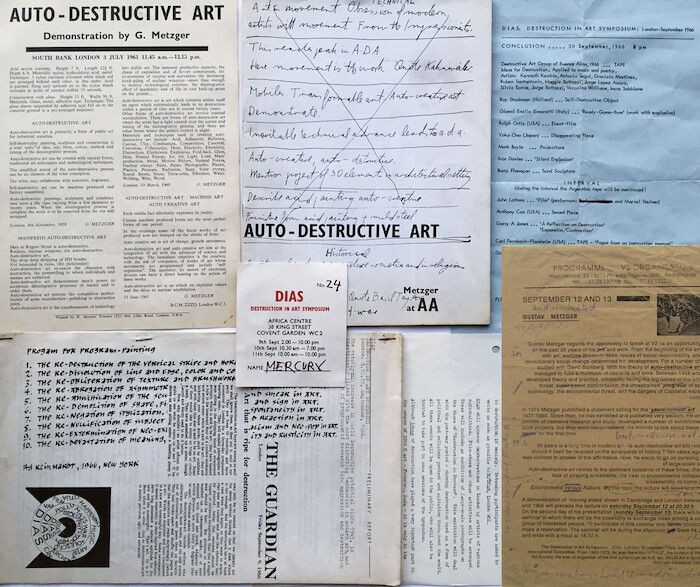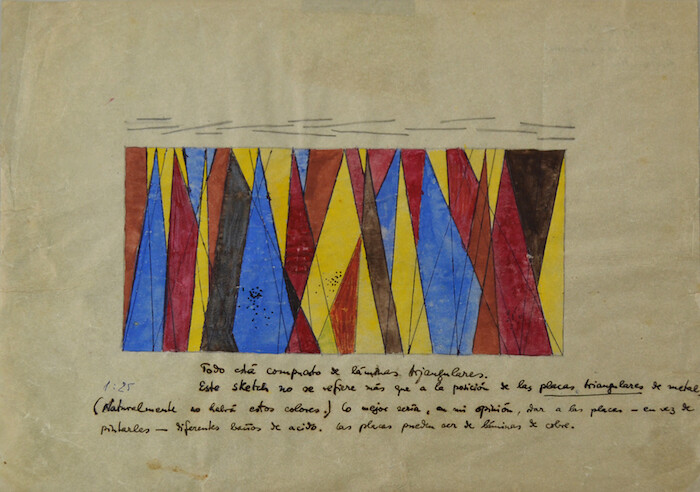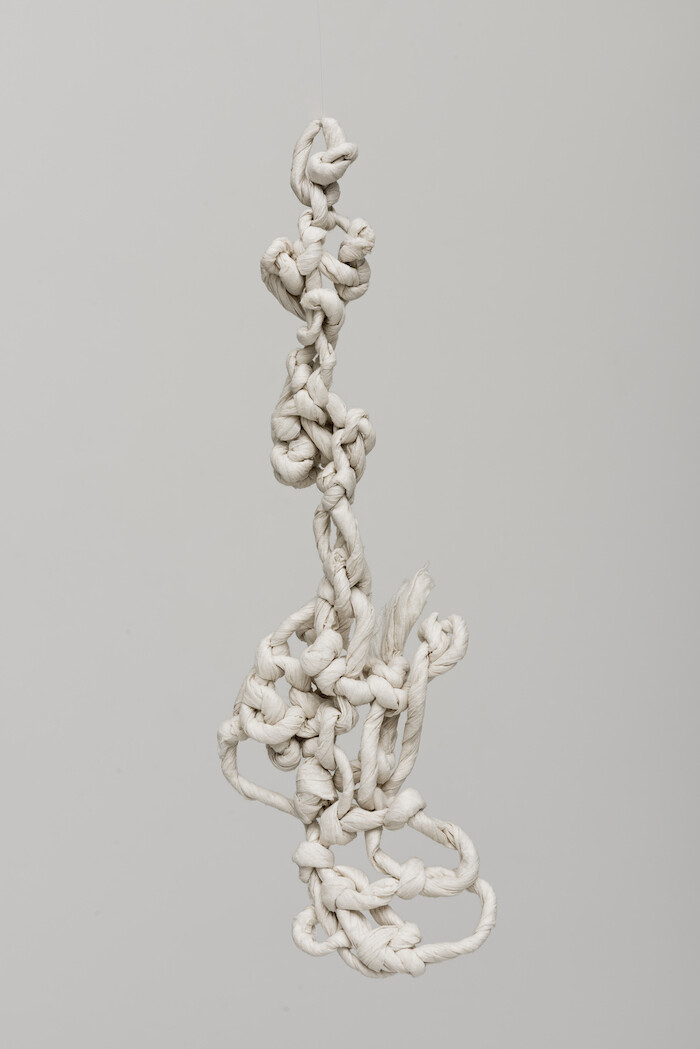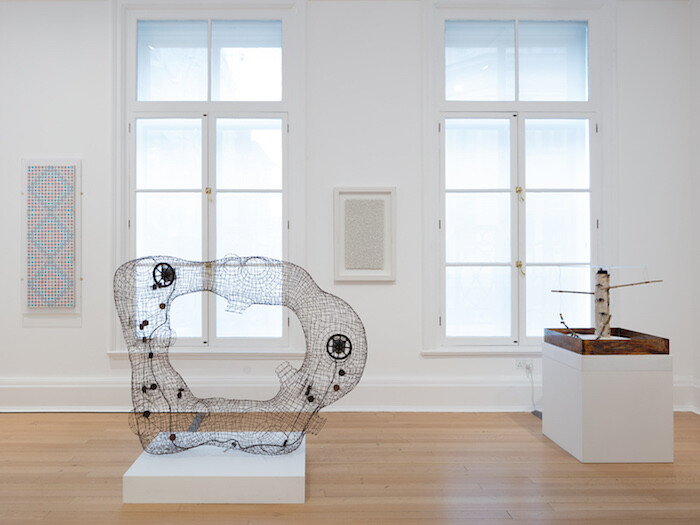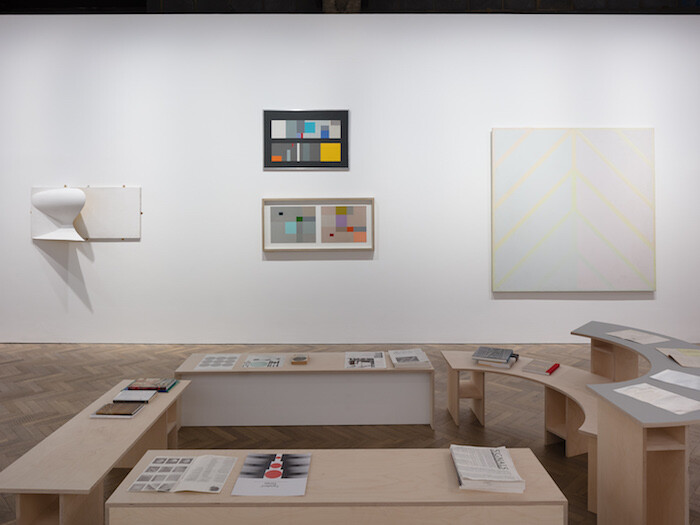“Signals: If You Like I Shall Grow” is an exhibition of works that come from a past that was alive to the future. Initiated by Mexico City’s kurimanzutto, held across the two spaces of London’s Thomas Dane gallery, and curated by Isobel Whitelegg, the exhibition echoes the interdisciplinary alliances of its subject matter: London gallery Signals’ activity between 1964 and 1966. As well as being a commercial entity, Signals was also an innovative project space, an experimental publishing endeavor, and a loosely associated set of artists primarily active between the UK (London and various regional centers) and Latin America (Venezuela and Brazil, primarily).
Both moderately sized spaces are dense with works, 42 in each. But an absence of durational work (with the exception of Gustav Metzger: Auto…
Spearheaded in the mid–1960s by artists David Medalla, Gustav Metzger, and Marcello Salvadori, alongside critic Guy Brett and curator Paul Keeler, Signals London belongs to an illustrious canon of mold-breaking galleries—from Peggy Guggenheim’s The Art of This Century in New York to London’s City Racing—set on challenging the status quo, be it through collaborative initiatives or experimental approaches. Signal’s enduring legacy is now being celebrated with an exhibition that is—fittingly—a transoceanic collaboration between two galleries: Mexico City’s kurimanzutto and its London host Thomas Dane.
Running only for two years, Signals opened in 1964 with the aim of fostering avant-garde experimental art and kinetic art in particular. The movement was flourishing in nearby Paris, gaining momentum thanks to a group…
“Signals: If You Like I Shall Grow” is an exhibition of works that come from a past that was alive to the future. Initiated by Mexico City’s kurimanzutto, held across the two spaces of London’s Thomas Dane gallery, and curated by Isobel Whitelegg, the exhibition echoes the interdisciplinary alliances of its subject matter: London gallery Signals’ activity between 1964 and 1966. As well as being a commercial entity, Signals was also an innovative project space, an experimental publishing endeavor, and a loosely associated set of artists primarily active between the UK (London and various regional centers) and Latin America (Venezuela and Brazil, primarily).
Both moderately sized spaces are dense with works, 42 in each. But an absence of durational work (with the exception of Gustav Metzger: Auto Destructive Art, by Harold Liversidge [1965] and Free Radicals by Len Lye [1958–79], shown consecutively on a monitor, on loop) and the careful editing of archive material (there’s a vitrine of editions near the entrance and, further into the gallery, a bench/table structure featuring excerpts from several publications), means that navigating through it is not an overwhelming documentation-heavy endeavor. There are no wall labels; the works are not divided by medium, geographical origin, theme, or chronology. Instead there was a carefully plotted visual exploration of various aspects of the kinetic. While jingle-jangle schools of kinetic art are relatively well documented in American and European contexts—increasingly so, as they contextualize art’s turn to performance and moving image works—this exhibition shows how artists from Latin America and the UK in this period, through drawings, paintings, sculptures and mechanical objects, were considering the kinetic in step with the Copernican revolutions of their time: increasing global connectivity brought by changes such as live broadcast media, early cybernetics, aeronautics and cosmonautics, and satellite technologies.
A suggestive evolutionary story is wryly told through works in Dane’s more recently opened space. Installed across two long, adjacent rooms, I begin at Li Yuan-chia’s oil on wood Untitled (1963), a small, uniformly red panel punctuated only by his signature to the lower right corner and several black oblong dots appearing at the composition’s center: tiny points that shrug in opposite directions, implying the nascent movement of three amoebae. Next to it, Mira Schendel’s three untitled works from her series “Crosses and Vertices” (1964–65) are raspy sketches with black oil on rice paper that act out the primal motions of nuclei following the Big Bang, graduating from a single line gesture to rapid and dynamic movement. The oil drawings are suspended in transparent Perspex frames hung from the ceiling slightly away from the wall, as if to exaggerate the material delicacy of these markings on their support, carrying this strange quality of vulnerability or mortality, of being barely there. Schendel’s Little Nothings (1966–67), a knotted mass woven from rice paper, hangs nearby, denoting a process of fusion and interlinking: like an unsure, asymmetric coil of DNA. All of these works, so non-scientifically rendered, question—with absorbing simplicity—ideas of origin and future.
A suspended sculptural disc containing smaller spheres (Gerhard von Graevenitz’s Doppelganger, 1964) following by a rotating horizontal disc turning at five rotations per minute (Liliane Lijn’s Reflections, 1964–65), allude to inter-planetary orbit, themes brought to land—as happens several times in the exhibition—with works of endearing humor and eccentricity. Four concrete poems by Dom Sylvester Houédard are drawn meticulously on small sheets of paper using a typewriter in black ink. In Cloud (1965), for example, each of the title’s five letters has been tapped into unique symmetric configurations on the paper’s upper margin, each letter a cloud, opaque but sturdy, funny and brilliant.
Humor was peppered throughout the show’s more whispering abstractions. Two sculptures by Harry Kramer (Grosses H, 1962–64, and Wire, 1964) stand upright and on plinths. Their distinctive outlines resemble the bulky protuberances of a Henry Moore combined with the more absurdist sensibility of an Ivor Cutler poem. Kramer’s carefully hand-wound steel latticing shows inner mechanisms that turn a round of wire, squeaking at a high pitch as it activates a series of steel-wrought discs inside, pulling around an upturned whisk, a mini Ferris wheel, and steel circles. The piece characterizes a shift from modernism’s sobriety to postmodern idiosyncrasy, heralding—in Robert Venturi, Steven Izenour, and Denise Scott Brown’s terms—the era of the “decorated shed.”1 Malcolm Carder’s acrylic glass sculpture Box (1969–70) and colored silk screen Untitled (1972) contain meticulously drawn flowcharts, the latter signaling the journey of information from the eye to the brain and the various pressures, distractions or wayward notions it encounters along the way.
Like the artists of our period, Signals’ associates were working through a phase of great political uncertainty and accelerated technological change. Among the many pleasures of the avoidance of archive piling and heavy labeling is that the visitor is perfectly able to imagine these works from the mid-1960s as being contemporary, both with one another—despite the artists’ geographic and political differences—and with many younger artists making work now. (Carder’s work, for instance, reminded me of Helen Marten) What this exhibition asserts feels consistent with Signals’ original method of cross-fertilization and reshuffling. It recognizes that when the work is strong enough, curatorial and art histories don’t need to be furiously sign-posted like a walk-through thesis, but can open themselves to interpretation and kinesis in the present.
Robert Venturi, Steven Izenour, and Denise Scott Brown, Learning from Las Vegas (Cambridge: MIT Press, 1972), 87.
Spearheaded in the mid–1960s by artists David Medalla, Gustav Metzger, and Marcello Salvadori, alongside critic Guy Brett and curator Paul Keeler, Signals London belongs to an illustrious canon of mold-breaking galleries—from Peggy Guggenheim’s The Art of This Century in New York to London’s City Racing—set on challenging the status quo, be it through collaborative initiatives or experimental approaches. Signal’s enduring legacy is now being celebrated with an exhibition that is—fittingly—a transoceanic collaboration between two galleries: Mexico City’s kurimanzutto and its London host Thomas Dane.
Running only for two years, Signals opened in 1964 with the aim of fostering avant-garde experimental art and kinetic art in particular. The movement was flourishing in nearby Paris, gaining momentum thanks to a group of Latin American artists—including Jesús Rafael Soto, Sergio Camargo, and Antonio Asis—who had settled there. Signals showcased these and other artists from the region. In the process, it became a pioneering Latin American art hub in the British capital, selling pieces to museums such as the Tate and the V&A, which became the seeds of these institutions’ Latin American art collections.
Although Signals is perhaps best known for having staged the first solo shows in London of artists like Lygia Clark and Mira Schendel, “If you like I shall grow”— carefully and sensitively curated by art historian Isobel Whitelegg, who specializes in Latin American art—focuses instead on the gallery’s less renowned program of group exhibitions, a series titled “Pilot and Soundings.” The result is an exceptional display of some 80 artworks that include many iconic pieces alongside rarely seen ones.
Looming in one of the rooms is one of Takis’s collectively titled “Signal” sculptures (1964), the series from which the nascent gallery took its name. Standing on a rough iron base, two elongated poles, tall and scrawny like a pair of orphaned Giacometti legs, culminate on two round bulbs flicking on and off like a beacon. Nearby, a satisfying selection of works by Medalla includes one of his most famous kinetic sculptures, Cloud Canyons (1963–2018), in which soap bubbles churn across Perspex tubes, creating flaky columns that raise and fall, threatening to take over the gallery floor. Hanging close to the bubble machine, a series of sketches made between 1963 and 1967 shine a light on a less familiar side of the Filipino artist: that of the draftsman. Expressive and gestural yet precise, these small biomorphic drawings momentarily reminded me of a restrained Roberto Matta.
Beguiling textures abound in the show, from the almost edible accumulations of Camargo’s 1968 Untitled Piece, a relief made of small white wood cylinders shining like candies, to the organic shapes of Hélio Oiticica’s B17 Bólide vidro 05 ‘Homenagem a Mondrian’ [B17 Glass bolide 05 ‘Tribute to Mondrian’] (1965), in which layers of gauze and hessian envelop a round glass bottle filled with a suspicious yellow liquid. Nearby, Liliane Lijn’s tiny experiments in Perspex and glass—Double Drilling (remade) (1961–2005) and Periscope Eyes (1966)—seem like the forerunners of puzzles like the Rubik’s Cube, which would entrance players across the world two decades later. The same geometrical playfulness can also be found in Malcolm Carder’s Box (1969–70), an acrylic glass vitrine that houses a swirling set of spirals, tubes, and gradients, like a futuristic pinball machine—think Duchamp’s The Large Glass (1915–23) colliding with the avant-garde aesthetic of the Italian radical design studio Archizoom Associati.
Across the room, a painting by Fred Bazler, one of less-known artists of the Signals’ coterie, captured my attention. Titled Four on Four, the 1967 canvas features a diagonal grid on a green and pink background. Pulsating and throbbing in my eyes, the yellow grid came in and out of focus, revealing orange and blue hues, before being sucked into the pastel background once again. But the work I found most fascinating among the trove was perhaps Salvadori’s 1965 Untitled, a bizarre sculpture made of intervened layers of Perspex, which looked scratched and bubbling, as if burnt. It is part of Salvadori’s “Trace Project” series, which he conceived as see-through architectural elements; a more environmental approach that he fully embraced post-Signals, returning to his roots as a trained architect.
The sheer amount of high quality work on display and the thorough research that went into its preparation, which took over two years, meant I often heard the almost magical words “museum quality” spoken during the show’s opening night. This ambitious exhibition would certainly look at home in an institution. In fact, only about 40 percent of the works are for sale, the rest having been loaned by either museums or private collections. Looking at Salvadori’s strange sculpture, which was unearthed from a north London storage facility where it had been stored for decades in his family’s care, I felt grateful that some commercial galleries can still, on occasion, feel more beholden to art history than to the tyrannies of the market.
Robert Venturi, Steven Izenour, and Denise Scott Brown, Learning from Las Vegas (Cambridge: MIT Press, 1972), 87.
